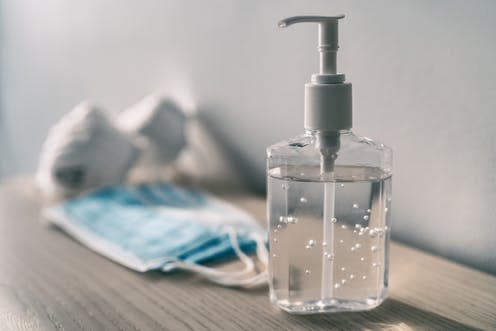Coronavirus: heavy use of hand sanitisers could boost antimicrobial resistance

Since the start of the coronavirus pandemic, scientists and governments have been advising people about the best hygiene practices to protect themselves. This advice has caused a significant surge in the sale and use of cleaning products and hand sanitisers. Unfortunately, these instructions rarely come with advice about using them responsibly or of the consequences of misuse.
But as with the misuse of antibiotics, the excessive use of cleaning products and hand sanitisers can lead to antimicrobial resistance in bacteria. There’s concern that the sudden overuse in cleaning products and hand sanitisers during the pandemic could lead to an increase in the number of antimicrobial-resistant bacterial species we encounter. This would put a greater strain on our already struggling healthcare systems, potentially leading to more deaths. What’s more, the problem could continue long after the current pandemic is over.
Antimicrobials (including antibiotic, antiprotozoal, antiviral and antifungal medicines) are important to our health. They help us fight against infections – particularly if your immune system is weak or compromised. However, some organisms (like bacteria) can change or mutate after being exposed to an antimicrobial. This makes them able to withstand the medicines designed to kill them. As the use and misuse of antimicrobials become more widespread, the number of resistant strains increases. Infections that were once easily treated are now becoming life threatening.
The processes that lead to antimicrobial resistance are many and varied. One route is through mutation. Some mutations occur after the bacteria’s DNA has been damaged. This can happen naturally during cell replication, or after exposure to genotoxic chemicals, which damage the cell’s DNA. Another route is if bacteria acquires resistant genes from another bacteria.
We usually (and correctly) associate antimicrobial resistance with the misuse of medications, such as antibiotics. Misuse could include failing to complete a course of antibiotics, or ignoring daily dose intervals. Both of these can increase the chance of the most resistant strains of bacteria in a population surviving and multiplying.
Read more: Hospital disinfectants should be regulated like antibiotics new study suggests
But bacteria can also acquire resistance after the inappropriate or excessive use of certain chemicals, including cleaning agents. Diluting sanitising agents, or using them intermittently and inefficiently, can provide a survival advantage to the most resistant strains. This ultimately leads to greater overall resistance.
Making matters worse are internet and social media “experts” offering advice about making homemade hand sanitisers they claim can kill the virus. For most of these products, there’s no evidence they’re effective. There’s also no consideration about any possible adverse effects from using them. What we do know is that many of these homemade products contain ingredients, such as alcohol, that have antibacterial properties in the right quantities. Anything that’s antibacterial has the potential to increase antimicrobial resistance.
Common ingredients
As a toxicologist, I’m concerned that more microorganisms could become antimicrobially resistant as a result of mutations caused by exposure to chemicals found in store-bought and homemade cleaning and hand sanitising products. Many of these (including phenols and hydrogen peroxide) have the potential to damage or alter DNA, and are sometimes referred to as genotoxic agents.
A small amount of DNA damage from normal cellular metabolism is common, particularly in rapidly multiplying bacteria. This damage is normally repaired properly. But if there’s extensive DNA damage, or if the repair isn’t correct, the cell may not survive.
However, mutations are more likely to happen in the few cases where the genotoxicity is not accurately repaired and the cell survives. A few of these cells may now have a survival advantage, such as antimicrobial resistance. The more frequent the genotoxic events, the more likely a few surviving cells will acquire antimicrobial resistance.

Many of the ingredients in various cleaning agents and hand sanitisers recommended by the World Health Organization have the potential to cause DNA damage and could lead to mutations necessary for antimicrobial resistance.
Common ingredients in many cleaning supplies and hand sanitisers include alcohols, quaternary ammonium compounds, phenols, hydrogen peroxide, surfactants, benzalkonium chloride and triclosan. The use of some of these compounds have already been linked to an increase in antimicrobial resistance. The current encouragement by the government to use products with these compounds – without clear warnings about the consequences of misuse – needs to be addressed.
When using hand sanitisers and cleaning products, treat them as you would a prescription medication. Read the instructions carefully, as any deviation can render them ineffective. Avoid diluting or combining pre-prepared products with other ones. Only make homemade sanitiser and cleaning products using recipes from government sites with ingredients bought from reputable stores.
Our attempts to protect ourselves from COVID-19 may also be creating an environment where even more antimicrobial resistant microorganisms can emerge. Given that antimicrobial resistance already causes more than 700,000 deaths a year worldwide, it’s important we act with caution to prevent further impact.
This article is republished from The Conversation under a Creative Commons license. Read the original article.

Winston Morgan works for University of East London.

 Yahoo News
Yahoo News 